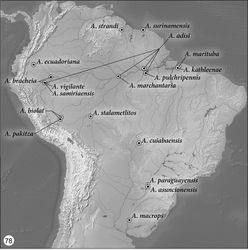Asklepia bracheia
| Notice: | This page is derived from the original publication listed below, whose author(s) should always be credited. Further contributors may edit and improve the content of this page and, consequently, need to be credited as well (see page history). Any assessment of factual correctness requires a careful review of the original article as well as of subsequent contributions.
If you are uncertain whether your planned contribution is correct or not, we suggest that you use the associated discussion page instead of editing the page directly. This page should be cited as follows (rationale):
Citation formats to copy and paste
BibTeX: @article{Erwin2014ZooKeys430, RIS/ Endnote: TY - JOUR Wikipedia/ Citizendium: <ref name="Erwin2014ZooKeys430">{{Citation See also the citation download page at the journal. |
Ordo: Coleoptera
Familia: Carabidae
Genus: Asklepia
Name
Asklepia bracheia Zamorano & Erwin sp. n. – Wikispecies link – ZooBank link – Pensoft Profile
Holotype
Perú, Loreto, circa Explornapo Camp, Río Napo, Cocha Shimagai, 3.3563°S, 73.0467°W, 88m, 13 June 1992 (T.L. Erwin, E. Pfuno S., F. Pfuno S.)(NMNH: ADP08121, female).
Derivation of specific epithet
The specific epithet, bracheia, is derived from the Greek βραχεια (small) and used as an adjective in reference to the small size of the elytra of these beetles.
Proposed english vernacular name
Short pattern-wing beetles.
Diagnosis
With the attributes of the genus Asklepia as described by Liebke (1938)[1] and as noted above under the generic diagnosis, and small-sized for the genus (SBL = 1.952–2.345 mm). Adults with head aurantiacus, prothorax and elytral maculae fulvous or aurantiacus in some individuals; elytron fuscous with basal proximal quadrant, medial lateral quadrant and apical proximal quadrant fulvous, lateral margin in all the quadrants fulvous; metasternum, abdominal sterna III-VI, and epipleuron fulvous, abdominal sternum VII fuscous; legs fulvous; antennal scape, pedicel and apical half of antennomere 3 testaceous, antennomeres 4-7 and basal half of 3 deeply infuscated, apical half of 7 and 8-11 white. Dorsal surface devoid of microsculpture, surface luster very shiny. Pronotum markedly convex with lateral margin effaced except just anterior to hind angle and there a simple bead; hind angle not very prominent. Elytral interneurs evident as short discontinuous rows of widely spaced punctures, rows effaced at medial quadrants of elytron, punctures fuscous; elytron substantially transparent.
Description
(Figs 41, 66). Habitus: (Fig. 41). Size: [See also Table 13] Medium-size for the genus; ABL = 2.343–2.537 mm, SBL = 1.952–2.344 mm, TW (total width) 1.074–1.274 mm, LP = 0.457–0.558 mm, WP = 0.557–0.701 mm, LE = 1.275–1.424 mm. Color: See diagnosis above. Luster: See diagnosis above. Head (Fig. 41): as in description for genus above. Prothorax. Pronotum (Fig. 41) slightly broad, about as wide as head across eyes (WH/WP, mean both sexes: 1.042), longer than head (LP/LH, mean both sexes: 1.590), wider than long (WP/LP: mean both sexes: 1.205); markedly cordiform, lateral margin effaced with seta at anterior third on slightly raised area; base markedly constricted; anterior angles feebly produced, hind angle slightly produced and setose; median line feebly defined, basal and apical transverse impressions evident as infuscated dots in the surface, surface smooth throughout. Pterothorax. Normal for genus, see description for genus above. Elytra moderately convex; at apical third twice as wide as head across eyes (WH/TW, mean both sexes: 0.529) and pronotum (WP/TW, mean both sexes: 0.507), longer than wide. Elytral interneurs evident as discontinuous rows of widely spaced punctures, rows effaced at lateral area of medial third and apical third, punctures present fuscous; elytron substantially transparent. Hind wings fully developed. Legs. Overall, normal for genus, see description for genus above. Abdominal sterna. Overall, normal for genus, see description for genus above. Male genitalia (Fig. 66, see Fig. 61 for attribute labels). Median lobe with phallobase long about a third the length of shaft, basal opening large, oriented parallel to shaft at apical third. Shaft narrow, slightly curved ventrally, dorsally sclerotized except for short ostium; in ventral aspect tapered toward rather moderately narrow rounded apex, in lateral aspect, a rounded apex. Parameres: left very large and broad, right small and triangular; apex of left paramere lobate much longer than right paramere about half the length of shaft (measured in left lateral aspect). Endophallus with 2 preapical spines. Female genitalia. Not investigated, presumably similar to that of Asklepia demiti sp. n.
Dispersal potential
These beetles are macropterous and probably capable of flight. They are moderately swift and agile runners.
Distribution
(Fig. 78). This species has been found at locations on the black-water systems of the upper Amazon River drainage system. But that does not at all indicate its real distribution: as has been pointed out above, very small beetles are inadequately sampled, especially in the Neotropics.
Way of life
See Erwin (1991)[2] for a general description. Adults of this species are active in the rainy season at the edges of streams and lakes in wet leaf litter and in muddy swales left by inundation of high river levels.
Other specimens examined
Perú, Loreto, 1 km SW Boca del Río Samiria, Vigilante post No. 1, 4.5005°S, 74.0659°W, 99m, 14 & 15 August 1991 (T.L. Erwin, G.E. Ball, D. Shpeley)(NMNH: ADP133028, female paratype, ADP133169, male paratype), 5 May 1990 (T.L. Erwin, G.E. Ball, D. Shpeley)(NMNH: ADP086696, female paratype, ADP086682, ADP086742, ADP067305, ADP067304, male paratypes); circa Explornapo Camp, Río Napo, Cocha Shimagai, 3.3563°S, 73.0467°W, 88m, 13 June 1992 (T.L. Erwin, E. Pfuno S., F. Pfuno S.)(NMNH: ADP008125, female paratype, ADP008072, ADP008120, male paratypes).
Original Description
- Erwin, T; Zamorano, L; 2014: A synopsis of the tribe Lachnophorini, with a new genus of Neotropical distribution and a revision of the Neotropical genus Asklepia Liebke, 1938 (Insecta, Coleoptera, Carabidae) ZooKeys, 430: 1-108. doi
Images
|



